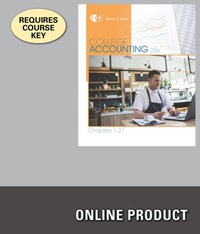Answered step by step
Verified Expert Solution
Question
1 Approved Answer
need help with transactions, adjusting entries, and closing entries transaction 2 use 4000 transaction 7 use 5% transaction 13 use 30000 transaction 19 use 30
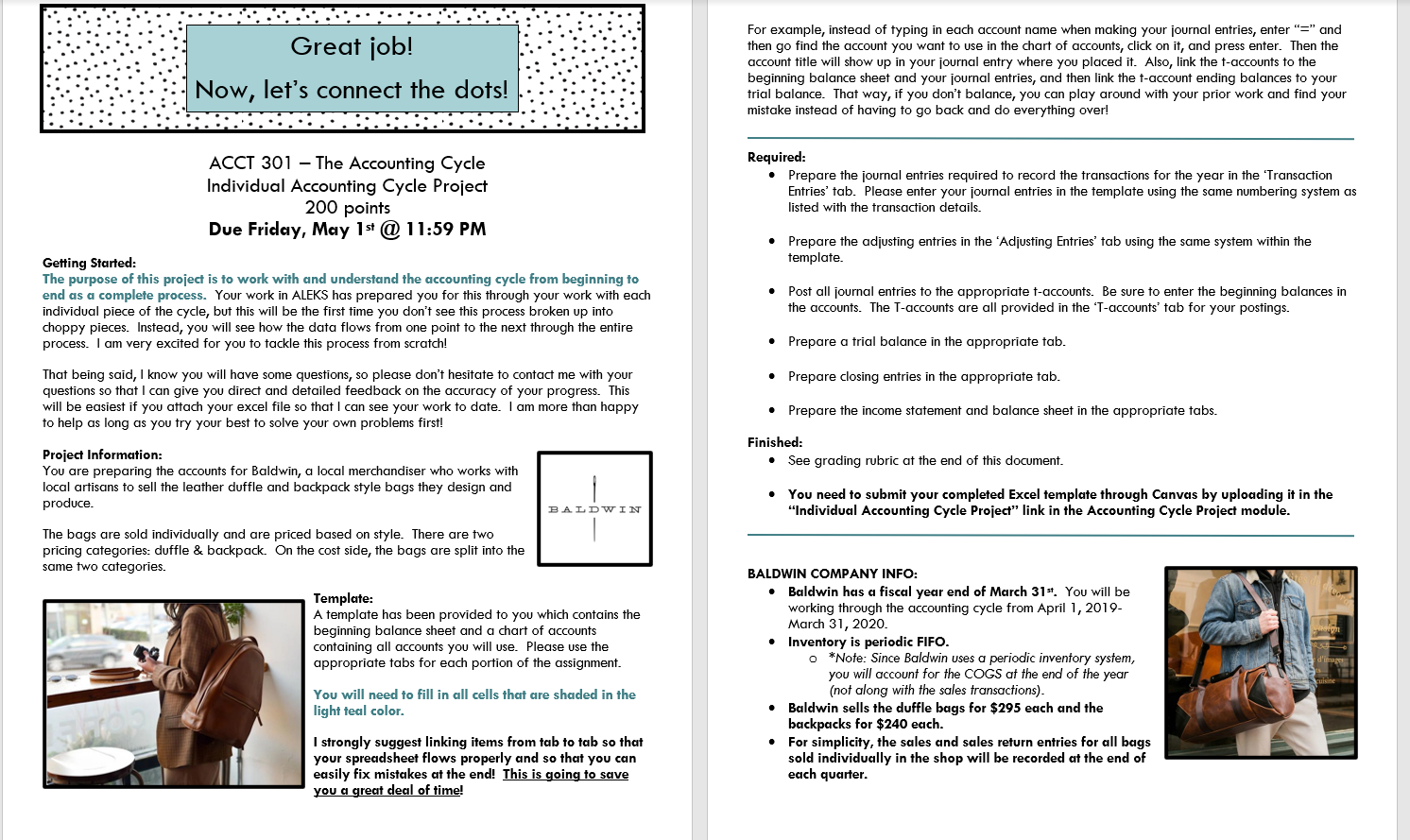
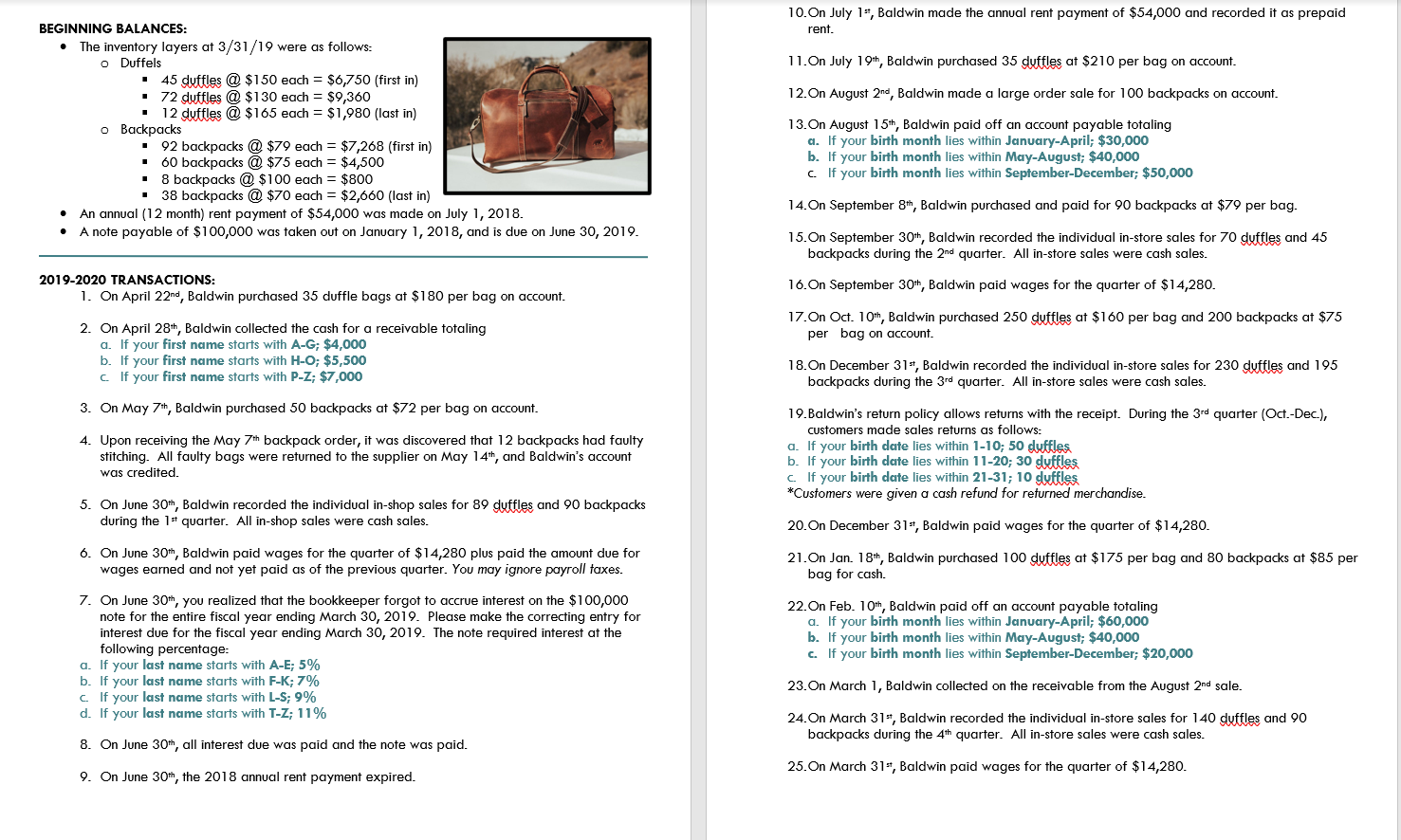
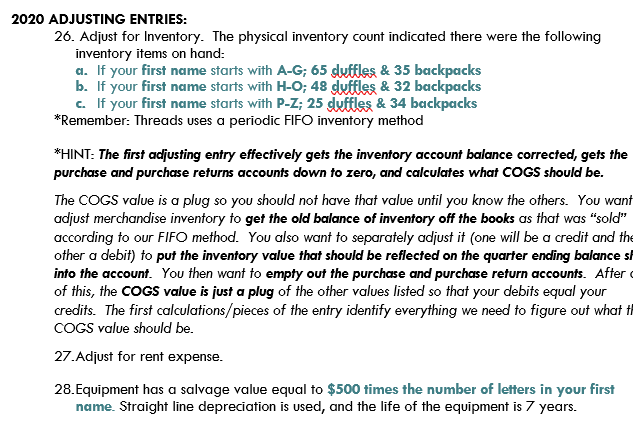
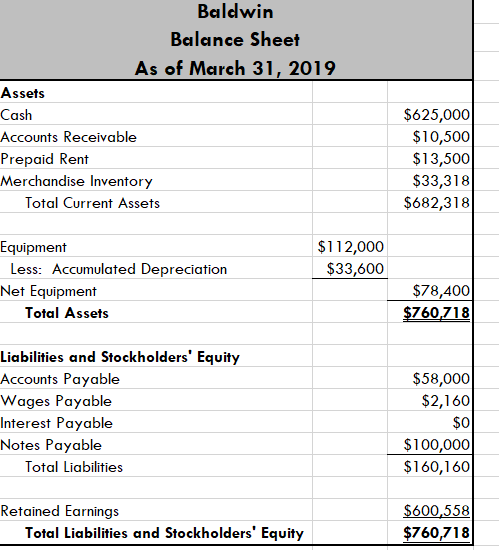

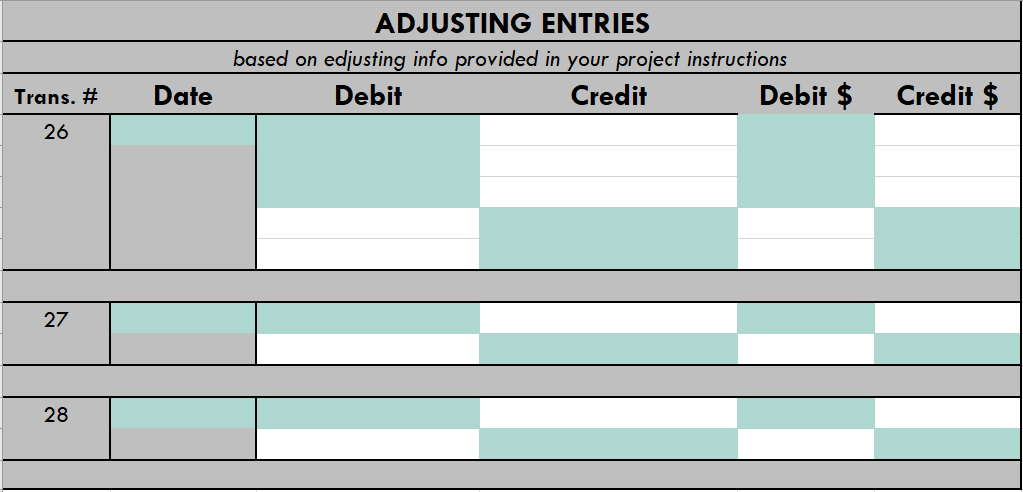
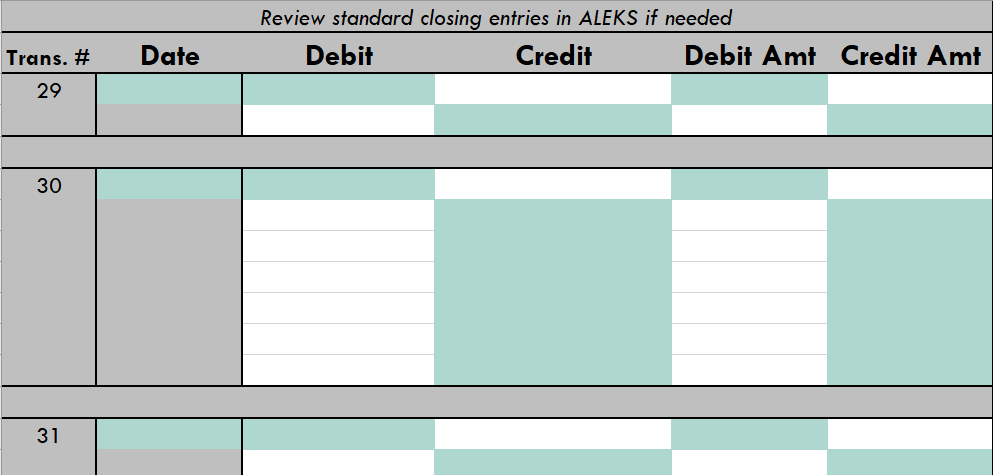
need help with transactions, adjusting entries, and closing entries
transaction 2 use 4000
transaction 7 use 5%
transaction 13 use 30000
transaction 19 use 30
transaction 22 use 60000
adjusting entry use 65 duffles & 35 backpacks
:::::::::::::::::::: :::: Great job! Now, let's connect the dots! :::::::::: ::::::: :::::::: For example, instead of typing in each account name when making your journal entries, enter"=" and then go find the account you want to use in the chart of accounts, click on it, and press enter. Then the account title will show up in your journal entry where you placed it. Also, link the t-accounts to the beginning balance sheet and your journal entries, and then link the t-account ending balances to your trial balance. That way, if you don't balance, you can play around with your prior work and find your mistake instead of having to go back and do everything over! ACCT 301 The Accounting Cycle Individual Accounting Cycle Project 200 points Due Friday, May 1st @ 11:59 PM Required: Prepare the journal entries required to record the transactions for the year in the 'Transaction Entries' tab. Please enter your journal entries in the template using the same numbering system as listed with the transaction details. Prepare the adjusting entries in the 'Adjusting Entries' tab using the same system within the template. Getting Started: The purpose of this project is to work with and understand the accounting cycle from beginning to end as a complete process. Your work in ALEKS has prepared you for this through your work with each individual piece of the cycle, but this will be the first time you don't see this process broken up into choppy pieces. Instead, you will see how the data flows from one point to the next through the entire process. I am very excited for you to tackle this process from scratch! Post all journal entries to the appropriate t-accounts. Be sure to enter the beginning balances in the accounts. The T-accounts are all provided in the 'T-accounts' tab for your postings. Prepare a trial balance in the appropriate tab. Prepare closing entries in the appropriate tab. That being said, I know you will have some questions, so please don't hesitate to contact me with your questions so that I can give you direct and detailed feedback on the accuracy of your progress. This will be easiest if you attach your excel file so that I can see your work to date. I am more than happy to help as long as you try your best to solve your own problems first! Prepare the income statement and balance sheet in the appropriate tabs. Finished: See grading rubric at the end of this document. Project Information: You are preparing the accounts for Baldwin, a local merchandiser who works with local artisans to sell the leather duffle and backpack style bags they design and produce. You need to submit your completed Excel template through Canvas by uploading it in the "Individual Accounting Cycle Project" link in the Accounting Cycle Project module. BALDWIN The bags are sold individually and are priced based on style. There are two pricing categories: duffle & backpack. On the cost side, the bags are split into the same two categories. Template: A template has been provided to you which contains the beginning balance sheet and a chart of accounts containing all accounts you will use. Please use the appropriate tabs for each portion of the assignment. BALDWIN COMPANY INFO: Baldwin has a fiscal year end of March 31st. You will be working through the accounting cycle from April 1, 2019- March 31, 2020. Inventory is periodic FIFO. o *Note: Since Baldwin uses a periodic inventory system, you will account for the COGS at the end of the year (not along with the sales transactions). Baldwin sells the duffle bags for $295 each and the backpacks for $240 each. For simplicity, the sales and sales return entries for all bags sold individually in the shop will be recorded at the end of each quarter. You will need to fill in all cells that are shaded in the light teal color. I strongly suggest linking items from tab to tab so that your spreadsheet flows properly and so that you can easily fix mistakes at the end! This is going to save you a great deal of time! 10. On July 1st, Baldwin made the annual rent payment of $54,000 and recorded it as prepaid rent. 11. On July 19th, Baldwin purchased 35 duffles at $210 per bag on account. 12. On August 2nd, Baldwin made a large order sale for 100 backpacks on account BEGINNING BALANCES: The inventory layers at 3/31/19 were as follows: o Duffels 45 duffles @ $150 each = $6,750 (first in) 72 duffles @ $130 each = $9,360 12 duffles @ $165 each = $1,980 (last in) o Backpacks 92 backpacks @ $79 each = $7,268 (first in) 60 backpacks @ $75 each = $4,500 8 backpacks @ $100 each = $800 38 backpacks @ $70 each = $2,660 (last in) An annual (12 month) rent payment of $54,000 was made on July 1, 2018. A note payable of $100,000 was taken out on January 1, 2018, and is due on June 30, 2019. 13. On August 15th, Baldwin paid off an account payable totaling a. If your birth month lies within January-April; $30,000 b. If your birth month lies within May-August; $40,000 c. If your birth month lies within September-December; $50,000 14.On September 8th, Baldwin purchased and paid for 90 backpacks at $79 per bag. 15. On September 30th, Baldwin recorded the individual in-store sales for 70 duffles and 45 backpacks during the 2nd quarter. All in-store sales were cash sales. 2019-2020 TRANSACTIONS: 1. On April 22nd, Baldwin purchased 35 duffle bags at $180 per bag on account. 16. On September 30th, Baldwin paid wages for the quarter of $14,280. 17. On Oct. 10th, Baldwin purchased 250 duffles at $160 per bag and 200 backpacks at $75 per bag on account. 2. On April 28th, Baldwin collected the cash for a receivable totaling a. If your first name starts with A-G; $4,000 b. If your first name starts with H-O; $5,500 c If your first name starts with P-Z; $7,000 18. On December 31st, Baldwin recorded the individual in-store sales for 230 duffles and 195 backpacks during the 3rd quarter. All in-store sales were cash sales. 3. On May 7th, Baldwin purchased 50 backpacks at $72 per bag on account. 4. Upon receiving the May 7th backpack order, it was discovered that 12 backpacks had faulty stitching. All faulty bags were returned to the supplier on May 14th, and Baldwin's account was credited. 19.Baldwin's return policy allows returns with the receipt. During the 3rd quarter (Oct.-Dec.), customers made sales returns as follows: a. If your birth date lies within 1-10; 50 duffles b. If your birth date lies within 11-20; 30 gyffles c If your birth date lies within 21-31; 10 dxffles *Customers were given a cash refund for returned merchandise. 5. On June 30th, Baldwin recorded the individual in-shop sales for 89 duffles and 90 backpacks during the 1st quarter. All in-shop sales were cash sales. 20. On December 31st, Baldwin paid wages for the quarter of $14,280. 6. On June 30th, Baldwin paid wages for the quarter of $14,280 plus paid the amount due for wages earned and not yet paid as of the previous quarter. You may ignore payroll taxes. 21. On Jan. 18+, Baldwin purchased 100 duffles at $175 per bag and 80 backpacks at $85 per bag for cash. 7. On June 30th, you realized that the bookkeeper forgot to accrue interest on the $100,000 note for the entire fiscal year ending March 30, 2019. Please make the correcting entry for interest due for the fiscal year ending March 30, 2019. The note required interest at the following percentage: a. If your last name starts with A-E; 5% b. If your last name starts with F-K; 7% c. If your last name starts with L-S; 9% d. If your last name starts with T-Z; 11% 22.On Feb. 10th, Baldwin paid off an account payable totaling a. If your birth month lies within January-April; $60,000 b. If your birth month lies within May-August; $40,000 c. If your birth month lies within September-December; $20,000 23. On March 1, Baldwin collected on the receivable from the August 2nd sale. 24.On March 31st, Baldwin recorded the individual in-store sales for 140 duffles and 90 backpacks during the 4th quarter. All in-store sales were cash sales. 8. On June 30th, all interest due was paid and the note was paid. 25. On March 31", Baldwin paid wages for the quarter of $14,280. 9. On June 30th, the 2018 annual rent payment expired. 2020 ADJUSTING ENTRIES: 26. Adjust for Inventory. The physical inventory count indicated there were the following inventory items on hand: a. If your first name starts with A-G; 65 duffles & 35 backpacks b. If your first name starts with H-O; 48 dyffles & 32 backpacks c. If your first name starts with P-Z; 25 dxffles & 34 backpacks *Remember: Threads uses a periodic FIFO inventory method *HINT: The first adjusting entry effectively gets the inventory account balance corrected, gets the purchase and purchase returns accounts down to zero, and calculates what COGS should be. The COGS value is a plug so you should not have that value until you know the others. You want adjust merchandise inventory to get the old balance of inventory off the books as that was "sold" according to our FIFO method. You also want to separately adjust it (one will be a credit and the other a debit) to put the inventory value that should be reflected on the quarter ending balance s into the account. You then want to empty out the purchase and purchase return accounts. After of this, the COGS value is just a plug of the other values listed so that your debits equal your credits. The first calculations/pieces of the entry identify everything we need to figure out what t COGS value should be. 27.Adjust for rent expense. 28. Equipment has a salvage value equal to $500 times the number of letters in your first name. Straight line depreciation is used, and the life of the equipment is 7 years. Baldwin Balance Sheet As of March 31, 2019 Assets Cash Accounts Receivable Prepaid Rent Merchandise Inventory Total Current Assets $625,000 $10,500 $13,500 $33,318 $682,318 $112,000 $33,600 Equipment Less: Accumulated Depreciation Net Equipment Total Assets $78,400 $760,718 Liabilities and Stockholders' Equity Accounts Payable Wages Payable Interest Payable Notes Payable Total Liabilities $58,000 $2,160 $0 $100,000 $160,160 Retained Earnings Total Liabilities and Stockholders' Equity $600,558 $760,718 Chart of Accounts Cash Accounts Receivable Prepaid Rent Merchandise Inventory Equipment Accumulated Depreciation Accounts Payable Wages Payable Interest Payable Notes Payable Retained Earnings Income Summary Sales Sales Returns Purchases Purchase Returns Cost of Goods Sold Wage Expense Rent Expense Interest Expense Depreciation Expense ADJUSTING ENTRIES based on edjusting info provided in your project instructions Debit Credit Debit $ Trans. # Date Credit $ 26 Review standard closing entries in ALEKS if needed Debit Credit Debit Amt Credit Amt Date Trans. # | 29 I 30 31 :::::::::::::::::::: :::: Great job! Now, let's connect the dots! :::::::::: ::::::: :::::::: For example, instead of typing in each account name when making your journal entries, enter"=" and then go find the account you want to use in the chart of accounts, click on it, and press enter. Then the account title will show up in your journal entry where you placed it. Also, link the t-accounts to the beginning balance sheet and your journal entries, and then link the t-account ending balances to your trial balance. That way, if you don't balance, you can play around with your prior work and find your mistake instead of having to go back and do everything over! ACCT 301 The Accounting Cycle Individual Accounting Cycle Project 200 points Due Friday, May 1st @ 11:59 PM Required: Prepare the journal entries required to record the transactions for the year in the 'Transaction Entries' tab. Please enter your journal entries in the template using the same numbering system as listed with the transaction details. Prepare the adjusting entries in the 'Adjusting Entries' tab using the same system within the template. Getting Started: The purpose of this project is to work with and understand the accounting cycle from beginning to end as a complete process. Your work in ALEKS has prepared you for this through your work with each individual piece of the cycle, but this will be the first time you don't see this process broken up into choppy pieces. Instead, you will see how the data flows from one point to the next through the entire process. I am very excited for you to tackle this process from scratch! Post all journal entries to the appropriate t-accounts. Be sure to enter the beginning balances in the accounts. The T-accounts are all provided in the 'T-accounts' tab for your postings. Prepare a trial balance in the appropriate tab. Prepare closing entries in the appropriate tab. That being said, I know you will have some questions, so please don't hesitate to contact me with your questions so that I can give you direct and detailed feedback on the accuracy of your progress. This will be easiest if you attach your excel file so that I can see your work to date. I am more than happy to help as long as you try your best to solve your own problems first! Prepare the income statement and balance sheet in the appropriate tabs. Finished: See grading rubric at the end of this document. Project Information: You are preparing the accounts for Baldwin, a local merchandiser who works with local artisans to sell the leather duffle and backpack style bags they design and produce. You need to submit your completed Excel template through Canvas by uploading it in the "Individual Accounting Cycle Project" link in the Accounting Cycle Project module. BALDWIN The bags are sold individually and are priced based on style. There are two pricing categories: duffle & backpack. On the cost side, the bags are split into the same two categories. Template: A template has been provided to you which contains the beginning balance sheet and a chart of accounts containing all accounts you will use. Please use the appropriate tabs for each portion of the assignment. BALDWIN COMPANY INFO: Baldwin has a fiscal year end of March 31st. You will be working through the accounting cycle from April 1, 2019- March 31, 2020. Inventory is periodic FIFO. o *Note: Since Baldwin uses a periodic inventory system, you will account for the COGS at the end of the year (not along with the sales transactions). Baldwin sells the duffle bags for $295 each and the backpacks for $240 each. For simplicity, the sales and sales return entries for all bags sold individually in the shop will be recorded at the end of each quarter. You will need to fill in all cells that are shaded in the light teal color. I strongly suggest linking items from tab to tab so that your spreadsheet flows properly and so that you can easily fix mistakes at the end! This is going to save you a great deal of time! 10. On July 1st, Baldwin made the annual rent payment of $54,000 and recorded it as prepaid rent. 11. On July 19th, Baldwin purchased 35 duffles at $210 per bag on account. 12. On August 2nd, Baldwin made a large order sale for 100 backpacks on account BEGINNING BALANCES: The inventory layers at 3/31/19 were as follows: o Duffels 45 duffles @ $150 each = $6,750 (first in) 72 duffles @ $130 each = $9,360 12 duffles @ $165 each = $1,980 (last in) o Backpacks 92 backpacks @ $79 each = $7,268 (first in) 60 backpacks @ $75 each = $4,500 8 backpacks @ $100 each = $800 38 backpacks @ $70 each = $2,660 (last in) An annual (12 month) rent payment of $54,000 was made on July 1, 2018. A note payable of $100,000 was taken out on January 1, 2018, and is due on June 30, 2019. 13. On August 15th, Baldwin paid off an account payable totaling a. If your birth month lies within January-April; $30,000 b. If your birth month lies within May-August; $40,000 c. If your birth month lies within September-December; $50,000 14.On September 8th, Baldwin purchased and paid for 90 backpacks at $79 per bag. 15. On September 30th, Baldwin recorded the individual in-store sales for 70 duffles and 45 backpacks during the 2nd quarter. All in-store sales were cash sales. 2019-2020 TRANSACTIONS: 1. On April 22nd, Baldwin purchased 35 duffle bags at $180 per bag on account. 16. On September 30th, Baldwin paid wages for the quarter of $14,280. 17. On Oct. 10th, Baldwin purchased 250 duffles at $160 per bag and 200 backpacks at $75 per bag on account. 2. On April 28th, Baldwin collected the cash for a receivable totaling a. If your first name starts with A-G; $4,000 b. If your first name starts with H-O; $5,500 c If your first name starts with P-Z; $7,000 18. On December 31st, Baldwin recorded the individual in-store sales for 230 duffles and 195 backpacks during the 3rd quarter. All in-store sales were cash sales. 3. On May 7th, Baldwin purchased 50 backpacks at $72 per bag on account. 4. Upon receiving the May 7th backpack order, it was discovered that 12 backpacks had faulty stitching. All faulty bags were returned to the supplier on May 14th, and Baldwin's account was credited. 19.Baldwin's return policy allows returns with the receipt. During the 3rd quarter (Oct.-Dec.), customers made sales returns as follows: a. If your birth date lies within 1-10; 50 duffles b. If your birth date lies within 11-20; 30 gyffles c If your birth date lies within 21-31; 10 dxffles *Customers were given a cash refund for returned merchandise. 5. On June 30th, Baldwin recorded the individual in-shop sales for 89 duffles and 90 backpacks during the 1st quarter. All in-shop sales were cash sales. 20. On December 31st, Baldwin paid wages for the quarter of $14,280. 6. On June 30th, Baldwin paid wages for the quarter of $14,280 plus paid the amount due for wages earned and not yet paid as of the previous quarter. You may ignore payroll taxes. 21. On Jan. 18+, Baldwin purchased 100 duffles at $175 per bag and 80 backpacks at $85 per bag for cash. 7. On June 30th, you realized that the bookkeeper forgot to accrue interest on the $100,000 note for the entire fiscal year ending March 30, 2019. Please make the correcting entry for interest due for the fiscal year ending March 30, 2019. The note required interest at the following percentage: a. If your last name starts with A-E; 5% b. If your last name starts with F-K; 7% c. If your last name starts with L-S; 9% d. If your last name starts with T-Z; 11% 22.On Feb. 10th, Baldwin paid off an account payable totaling a. If your birth month lies within January-April; $60,000 b. If your birth month lies within May-August; $40,000 c. If your birth month lies within September-December; $20,000 23. On March 1, Baldwin collected on the receivable from the August 2nd sale. 24.On March 31st, Baldwin recorded the individual in-store sales for 140 duffles and 90 backpacks during the 4th quarter. All in-store sales were cash sales. 8. On June 30th, all interest due was paid and the note was paid. 25. On March 31", Baldwin paid wages for the quarter of $14,280. 9. On June 30th, the 2018 annual rent payment expired. 2020 ADJUSTING ENTRIES: 26. Adjust for Inventory. The physical inventory count indicated there were the following inventory items on hand: a. If your first name starts with A-G; 65 duffles & 35 backpacks b. If your first name starts with H-O; 48 dyffles & 32 backpacks c. If your first name starts with P-Z; 25 dxffles & 34 backpacks *Remember: Threads uses a periodic FIFO inventory method *HINT: The first adjusting entry effectively gets the inventory account balance corrected, gets the purchase and purchase returns accounts down to zero, and calculates what COGS should be. The COGS value is a plug so you should not have that value until you know the others. You want adjust merchandise inventory to get the old balance of inventory off the books as that was "sold" according to our FIFO method. You also want to separately adjust it (one will be a credit and the other a debit) to put the inventory value that should be reflected on the quarter ending balance s into the account. You then want to empty out the purchase and purchase return accounts. After of this, the COGS value is just a plug of the other values listed so that your debits equal your credits. The first calculations/pieces of the entry identify everything we need to figure out what t COGS value should be. 27.Adjust for rent expense. 28. Equipment has a salvage value equal to $500 times the number of letters in your first name. Straight line depreciation is used, and the life of the equipment is 7 years. Baldwin Balance Sheet As of March 31, 2019 Assets Cash Accounts Receivable Prepaid Rent Merchandise Inventory Total Current Assets $625,000 $10,500 $13,500 $33,318 $682,318 $112,000 $33,600 Equipment Less: Accumulated Depreciation Net Equipment Total Assets $78,400 $760,718 Liabilities and Stockholders' Equity Accounts Payable Wages Payable Interest Payable Notes Payable Total Liabilities $58,000 $2,160 $0 $100,000 $160,160 Retained Earnings Total Liabilities and Stockholders' Equity $600,558 $760,718 Chart of Accounts Cash Accounts Receivable Prepaid Rent Merchandise Inventory Equipment Accumulated Depreciation Accounts Payable Wages Payable Interest Payable Notes Payable Retained Earnings Income Summary Sales Sales Returns Purchases Purchase Returns Cost of Goods Sold Wage Expense Rent Expense Interest Expense Depreciation Expense ADJUSTING ENTRIES based on edjusting info provided in your project instructions Debit Credit Debit $ Trans. # Date Credit $ 26 Review standard closing entries in ALEKS if needed Debit Credit Debit Amt Credit Amt Date Trans. # | 29 I 30 31Step by Step Solution
There are 3 Steps involved in it
Step: 1

Get Instant Access to Expert-Tailored Solutions
See step-by-step solutions with expert insights and AI powered tools for academic success
Step: 2

Step: 3

Ace Your Homework with AI
Get the answers you need in no time with our AI-driven, step-by-step assistance
Get Started


